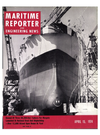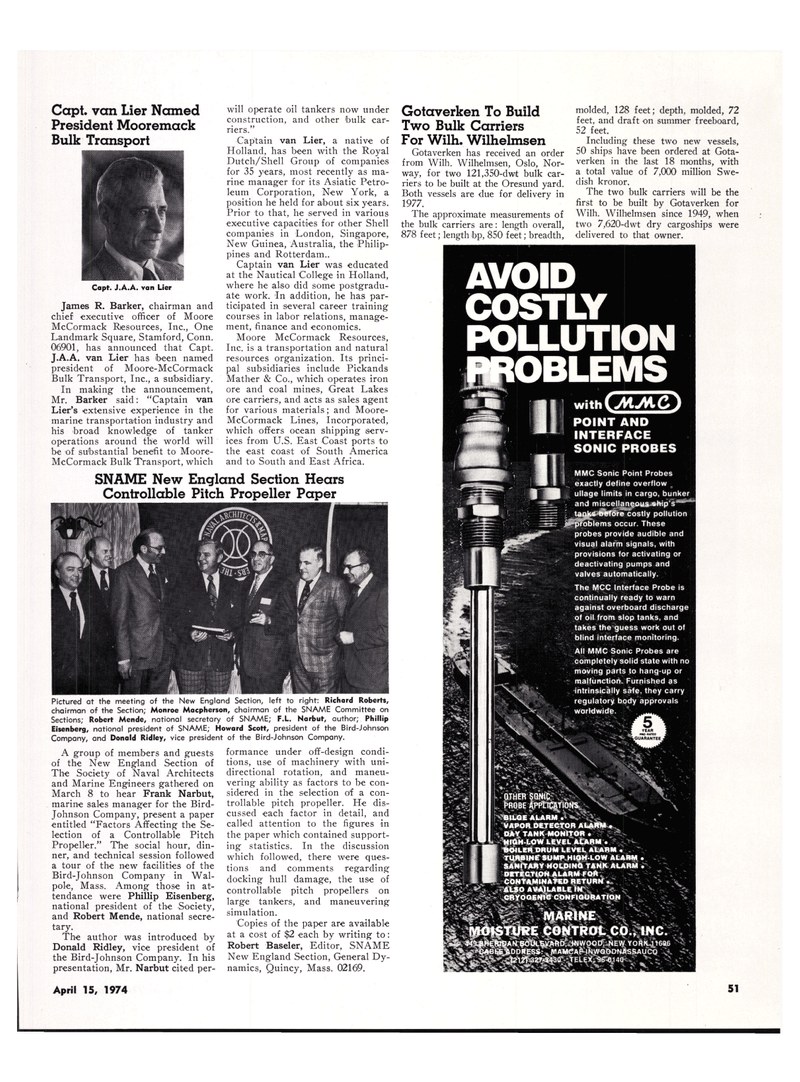
Page 50: of Maritime Reporter Magazine (April 15, 1974)
Read this page in Pdf, Flash or Html5 edition of April 15, 1974 Maritime Reporter Magazine
Capt. van Lier Named
President Mooremack
Bulk Transport
Capt. J.A.A. van Lier
James R. Barker, chairman and chief executive officer of Moore
McCormack Resources, Inc., One
Landmark Square, Stamford, Conn. 06901, has announced that Capt.
J.A.A. van Lier has been named president of Moore-McCormack
Bulk Transport, Inc., a subsidiary.
In making the announcement,
Mr. Barker said: "Captain van
Lier's extensive experience in the marine transportation industry and his broad knowledge of tanker operations around the world will be of substantial benefit to Moore-
McCormack Bulk Transport, which will operate oil tankers now under construction, and other bulk car- riers."
Captain van Lier, a native of
Holland, has been with the Royal
Dutch/Shell Group of companies for 35 years, most recently as ma- rine manager for its Asiatic Petro- leum Corporation, New York, a position he held for about six years.
Prior to that, he served in various executive capacities for other Shell companies in London, Singapore,
New Guinea, Australia, the Philip- pines and Rotterdam..
Captain van Lier was educated at the Nautical College in Holland, where he also did some postgradu- ate work. In addition, he has par- ticipated in several career training courses in labor relations, manage- ment, finance and economics.
Moore McCormack Resources,
Inc. is a transportation and natural resources organization. Its princi- pal subsidiaries include Pickands
Mather & Co., which operates iron ore and coal mines, Great Lakes ore carriers, and acts as sales agent for various materials; and Moore-
McCormack Lines, Incorporated, which offers ocean shipping serv- ices from U.S. East Coast ports to the east coast of South America and to South and East Africa.
Gotaverken To Build
Two Bulk Carriers
For Wilh. Wilhelmsen
Gotaverken has received an order from Wilh. Wilhelmsen, Oslo, Nor- way, for two 121,350-dwt bulk car- riers to be built at the Oresund yard.
Both vessels are due for delivery in 1977.
The approximate measurements of the bulk carriers are: length overall, 878 feet; length bp, 850 feet; breadth, molded, 128 feet; depth, molded, 72 feet, and draft on summer freeboard, 52 feet.
Including these two new vessels, 50 ships have been ordered at Gota- verken in the last 18 months, with a total value of 7,000 million Swe- dish kronor.
The two bulk carriers will be the first to be built by Gotaverken for
Wilh. Wilhelmsen since 1949, when two 7,620-dwt dry cargoships were delivered to that owner.
SNAME New England Section Hears
Controllable Pitch Propeller Paper
Pictured at the meeting of the New England Section, left to right: Richard Roberts, chairman of the Section; Monroe Macpherson, chairman of the SNAME Committee on
Sections; Robert Mende, national secretary of SNAME; F.L. Narbut, author; Phillip
Eisenberg, national president of SNAME; Howard Scott, president of the Bird-Johnson
Company, and Donald Ridley, vice president of the Bird-Johnson Company.
A group of members and guests of the New England Section of
The Society of Naval Architects and Marine Engineers gathered on
March 8 to hear Frank Narbut, marine sales manager for the Bird-
Johnson Company, present a paper entitled "Factors Affecting the Se- lection of a Controllable Pitch
Propeller." The social hour, din- ner, and technical session followed a tour of the new facilities of the
Bird-Johnson Company in Wal- pole, Mass. Among those in at- tendance were Phillip Eisenberg, national president of the Society, and Robert Mende, national secre- tary.
The author was introduced by
Donald Ridley, vice president of the Bird-Johnson Company. In his presentation, Mr. Narbut cited per- formance under off-design condi- tions, use of machinery with uni- directional rotation, and maneu- vering ability as factors to be con- sidered in the selection of a con- trollable pitch propeller. He dis- cussed each factor in detail, and called attention to the figures in the paper which contained support- ing statistics. In the discussion which followed, there were ques- tions and comments regarding docking hull damage, the use of controllable pitch propellers on large tankers, and maneuvering simulation.
Copies of the paper are available at a cost of $2 each by writing to:
Robert Baseler, Editor, SNAME
New England Section, General Dy- namics, Quincy, Mass. 02169. lETUnt*
AVOID COSTLY
POLLUTION RPOBLEMS
POINT AND
INTERFACE
SONIC PROBES
MMC Sonic Point Probes exactly define overflow = ullage limits in cargo, bunker and m I sc e llanpou&Ahi p' s tanks before costly pollution
PfjFoblems occur. These probes provide audible and visual alarm signals, with provisions for activating or deactivating pumps and valves automatically.
The MCC Interface Probe is continually ready to warn against overboard discharge of oil from slop tanks, and takes the guess work out of blind interface monitoring.
All MMC Sonic Probes are completely solid state with no moving parts to hang-up or malfunction. Furnished as •intrinsically safe, they carry regulatory body approvals worldwide. ^ >4
Li flliP
April 15, 1974 51

 49
49

 51
51
